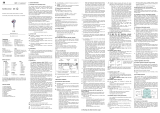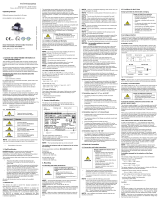
DOCT-0258D 192382 03/2012
8
Subject to modifications without notice
Pepperl+Fuchs Group
www.pepperl-fuchs.com
USA: +1 330 486 0002
Singapore: +65 6779 9091
Copyright Pepperl+Fuchs
Germany: +49 621 776 2222
Operating Instructions
Surge Protection Barriers
Safety Information for P-LB-*.*.*
plug-in modules
The corresponding data sheets, the Declaration of Conformity,
the EC-Type Examination Certificate and applicable
certificates (see data sheet) are an integral part of this
document.
Intended use
Laws and regulations applicable to the usage or planned
purpose of usage must be observed. Devices are only
approved for proper usage in accordance with intended use.
Improper handling will result in voiding of any warrantee or
manufacturer's responsibility.
Plug-in terminal modules are used as modules positioned
upstream in the circuit from the corresponding electrical
equipment. They make it possible to protect against
overvoltages originating from various causes (lightning strikes,
switching processes, etc.). This is achieved by diverting the
transient current and limiting the voltage throughout the
duration of the overvoltage surge. Various modules are
available for protecting 2, 3, 4 or 6 conductors. The
assignment of input connections of plug-in terminal
modules/intrinsically safe equipment (binary or analog signals)
corresponds to that of the following related equipment (see the
corresponding data sheets). Plug-in terminal modules should
only be used in combination with a device of the K-System.
Protection of operating personnel and the system is not
ensured if the product is not used in accordance with its
intended use.
Intrinsic safety circuits that were operated with circuits of other
types of protection may not be used as intrinsically safe
circuits afterwards.
Application
Plug-in terminal modules can be installed within the hazardous
area of Zone 2/Div. 2. They can be used for intrinsically safe
circuits up to Ex ia IIC. The ignition protection class is
determined by the connected intrinsically safe circuit of the
corresponding electrical equipment.
Plug-in terminal modules are not used to separate intrinsically
safe circuits from non-intrinsically safe circuits.
Plug-in terminal modules must not be installed in dust Ex-
zones.
Installation and commissioning in
connection with hazardous areas
Commissioning and installation must be performed only by
specialists who are trained specifically for this purpose.
The quality of the ground is a significant precondition for
problem-free overvoltage protection. Short connections and
large cable cross-sections are basic requirements for effective
protection. These requirements can be fulfilled through the use
of appropriate accessories (see data sheets).
Plug-in terminal modules are designed in the IP20 protection
class in accordance with EN 60529 and must be accordingly
protected against adverse environmental conditions such as
splashed water or dirt beyond pollution degree 2.
Plug-in terminal modules can be installed inside the hazardous
area of Zone 2/Div. 2. Since plug-in terminal modules are
always used in combination with devices of the K-System, the
devices of the K-System must, in this case, be suitable for use
in Zone 2/Div. 2. The devices of the K-System must then be
installed only in Zone 2/Div. 2 if a corresponding Declaration of
Conformity for a named location or a manufacturer's
Declaration of Conformity is present. For information on
whether this condition has been met, please refer to the data
sheets for the devices of the K-System. The instruction
manual, the Declaration of Conformity of a named location or
the manufacturer's Declaration of Conformity of devices of the
K-System and the information in them must be followed.
Depending on the ignition protection class, the circuits of plug-
in terminal modules may be directed in Zone 1 or 0. Special
attention must be paid to a secure separation from all non-
intrinsically safe circuits in this context. A shortest path
distance of at least 50 mm must be maintained between
intrinsically safe and non-intrinsically safe conducting terminal
blocks during assembly. The ignition protection class is
determined by the connected intrinsically safe circuit of the
corresponding electrical equipment.
The installation of the intrinsically safe circuits is to be
conducted in accordance with the relevant installation
regulations.
The respective maximum values of the field device, the plug-in
terminal modules and the corresponding electrical equipment
as defined by explosion protection must be observed for
interconnecting with intrinsically safe electrical equipment
(proof of intrinsic safety). EN 60079-14/
IEC 60079-14 must be observed (where appropriate).










